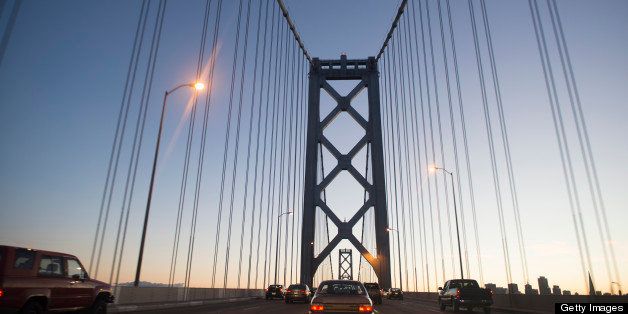
OAKLAND -- Strategically positioned high above the water, in a narrow crawl space between the new Bay Bridge deck and the top of its big pier east of the tower, instruments are listening for the sounds of cracking inside steel anchor rods.
Caltrans placed 10 acoustic emission sensors on select rods in early April after some of the massive bolts -- 3 inches in diameter and 17 to 24 feet long -- snapped and triggered widespread worry about the replacement eastern span's seismic safety.
The instrument records the energy produced when a crack initiates, spreads or moves within the rod, said Caltrans materials engineer Bahjat Bagher, who showed off the testing late Friday. But so far, the rods being tested are quiet, a great relief to the agency.
If the bolts -- fabricated in 2010, two years after the 32 bolts that broke -- were also faulty and had to be replaced, the cost to make the $6.4 billion bridge safe for motorists would rise, and Caltrans would face an even greater hurdle to opening the bridge on time.
A second test for hardness is also showing favorable results, although a third saltwater corrosion test is still to come.
"We are pretty confident that we don't have an immediate failure issue with these bolts, but we want to have a strong level of confidence over the long-term," said Toll Bridge Program Manager Tony Anziano.
It's small a piece of good news amid mounting concerns about the $6.4 billion span's ability to withstand the next big earthquake. The long, hefty anchor rods tie the bridge deck and pier columns to the shear keys and bearings that help control sway and uplift during a quake.
The scheduled Sept. 3 opening is already in jeopardy as the three agencies co-managing the bridge construction scramble to design a structure than can replace the steel rods. A third of the 96 bolts installed in 2008 broke in March.
Caltrans and the California Transportation Commission are scheduled to brief the Bay Area Toll Authority about the best repair option, timetable and costs Wednesday morning.
Tests on the remaining 192 anchor rods in adjacent shear keys and bearings suggest the fracturing problem may be limited to the earlier batch.
Caltrans steel inspector Jason Gramlick on Friday afternoon demonstrated how technicians are testing the hardness of the anchor rods adjacent to those where the bolts snapped. Harder rods could be more brittle and more subject to cracking.
He placed the tip of a handheld ultrasonic contact impedance instrument on the end of a rod, which oscillates a diamond-tipped point against the steel's surface and measures the rate at which the material is displaced.
Within minutes, Gramlick had four readings on the Rockwell C hardness scale, of which the average was 35.
In contract documents dated from 2005, Caltrans specified a hardness level range of 31 to 39. But this month, the agency dropped the maximum to 35 for all replacement fasteners in light of what happened with the 2008 bolts, Anziano said.
The 2008 bolts had an average hardness of 37, which experts say may have contributed to their failure.
The third test involves placing four rods from the 2010 group into a sealed salt water bath for 25 days. During the soak, technicians will slowly increase the tension on the rods, Anziano explained.
The saltwater test, which will be conducted at test beds installed near the base of the bridge in Oakland, is designed to replicate extreme environmental conditions and see if the rods become brittle and break. Ohio-based Dyson Corp. fabricated all 288 anchor bolts and most of the other 2,018 steel fasteners on the bridge made out of the same grade and type of steel. Vulcan Steel Products in Alabama also made some of the 2010 fasteners.
Caltrans engineers blame the fracturing on a well-known phenomenon where hydrogen atoms invade the spaces between steel's crystalline structure and weaken it. The harder the steel and the greater the tension placed on the bolt, the more susceptible it is to hydrogen embrittlement.
The anchor rods in the shear keys and bearings are tightened to 70 percent of their capacity, the highest on the bridge. Less than half of all 2,306 high-strength steel fasteners on the span are subjected to loads of more than 50 percent, the threshold experts consider more risky for hydrogen assault.
Contact Lisa Vorderbrueggen at 925-945-4773, politicswithlisav.blogspot.com or Twitter.com/lvorderbrueggen. ___
(c)2013 the Contra Costa Times (Walnut Creek, Calif.)
Visit the Contra Costa Times (Walnut Creek, Calif.) at www.contracostatimes.com
Distributed by MCT Information Services
